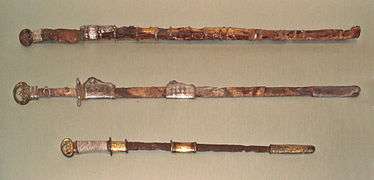Chokutō

The chokutō (直刀, "straight sword") is a straight, one-edged Japanese sword that was produced prior to the 10th century. Its basic style is likely derived from similar swords of ancient China.[1][2] Chokutō were used on foot for stabbing or slashing and were worn hung from the waist.[3][4][5] Until the Heian period such swords were called tachi (大刀), which should not be confused with tachi written as 太刀 referring to curved swords.[6]
History
The production of swords in Japan is divided into specific time periods:
- Jokoto (ancient swords, until around 900 A.D.)
- Koto (old swords from around 900–1596)
- Shinto (new swords 1596–1780)
- Shinshinto (new new swords 1781–1876)
- Gendaito (modern swords 1876–1945)[7]
- Shinsakuto (newly made swords 1953–present)[8]
Chokutō was among the earliest in the history of Japanese sword-forging as its basic style and forging techniques probably originated in ancient China and were brought to Japan by way of Korea in the 3rd centuries.[9][10] It was created before the development of differential tempering in Japanese swordsmithing. Chokutō typically come in hira-zukuri and kiriha-zukuri tsukurikomi (blade styles) which make them very distinct from later tachi and katana which rarely use these forms. The distinctive feature of the chokutō is the straight blade, similar to the ancient Chinese swords found in China around the 2nd century BCE to the 10th century CE.
Though curved blades are as old as the sword itself, they did not become widespread in Asia and the Middle East until after the dominance of the Mongol Empire. Japanese warriors of the Kamakura Shogunate experienced the effectiveness and lethality of curved blades firsthand during the Mongol invasions of Japan. Rudimentary forms what would eventually become the tachi gradually began to eclipse the chokutō in popularity as the curved blades demonstrated greater ease of handling and lethality in mounted combat.
Very few examples of chokutō mountings remain, although enough to reconstruct their various typologies which always followed Chinese and Korean models; this is evident in one of the last Kofun period sword types developed, the single-edged warabitetō (蕨手刀).
Gallery
-

Shitennō-ji Shichiseiken, single-edged straight sword, Asuka period
-

Hilts of Japanese straight swords, Kofun period, 6-7th century, Met Museum.
-

Two Chinese swords (top) of the Sui Dynasty. Bottom: Japanese sword with scabbard, Kofun period, 6th century, Met Museum.
-

Sword hilts, end of the Kofun period, Japan, 6th century. Musée Guimet.
See also
References
- ↑ "Katana:The Samurai Sword",Stephen Turnbull,2010,P.16
- ↑ The connoisseur's book of Japanese swords, Kōkan Nagayama, Kodansha International, Mar 30 1998, P.12
- ↑ The Japanese sword, Kanzan Satō, Kodansha International, May 30, 1983 P.28 "Katana:The Samurai Sword",Stephen Turnbull,2010,P.16
- ↑ The connoisseur's book of Japanese swords, Kōkan Nagayama, Kodansha International, Mar 30 1998, P.12
- ↑ The Japanese sword, Kanzan Satō, Kodansha International, May 30, 1983 P.28
- ↑ "太刀・大刀". Daijirin at kotobank.jp (in Japanese). Retrieved July 22, 2015.
- ↑ Clive Sinclaire (1 November 2004). Samurai: The Weapons and Spirit of the Japanese Warrior. Lyons Press. pp. 40–58. ISBN 978-1-59228-720-8.
- ↑ トム岸田 (24 September 2004). 靖国刀. Kodansha International. p. 42. ISBN 978-4-7700-2754-2.
- ↑ "The Craft of the Japanese Sword",Leon Kapp,1987,P.20
- ↑ "Katana:The Samurai Sword",Stephen Turnbull,2010,P.16